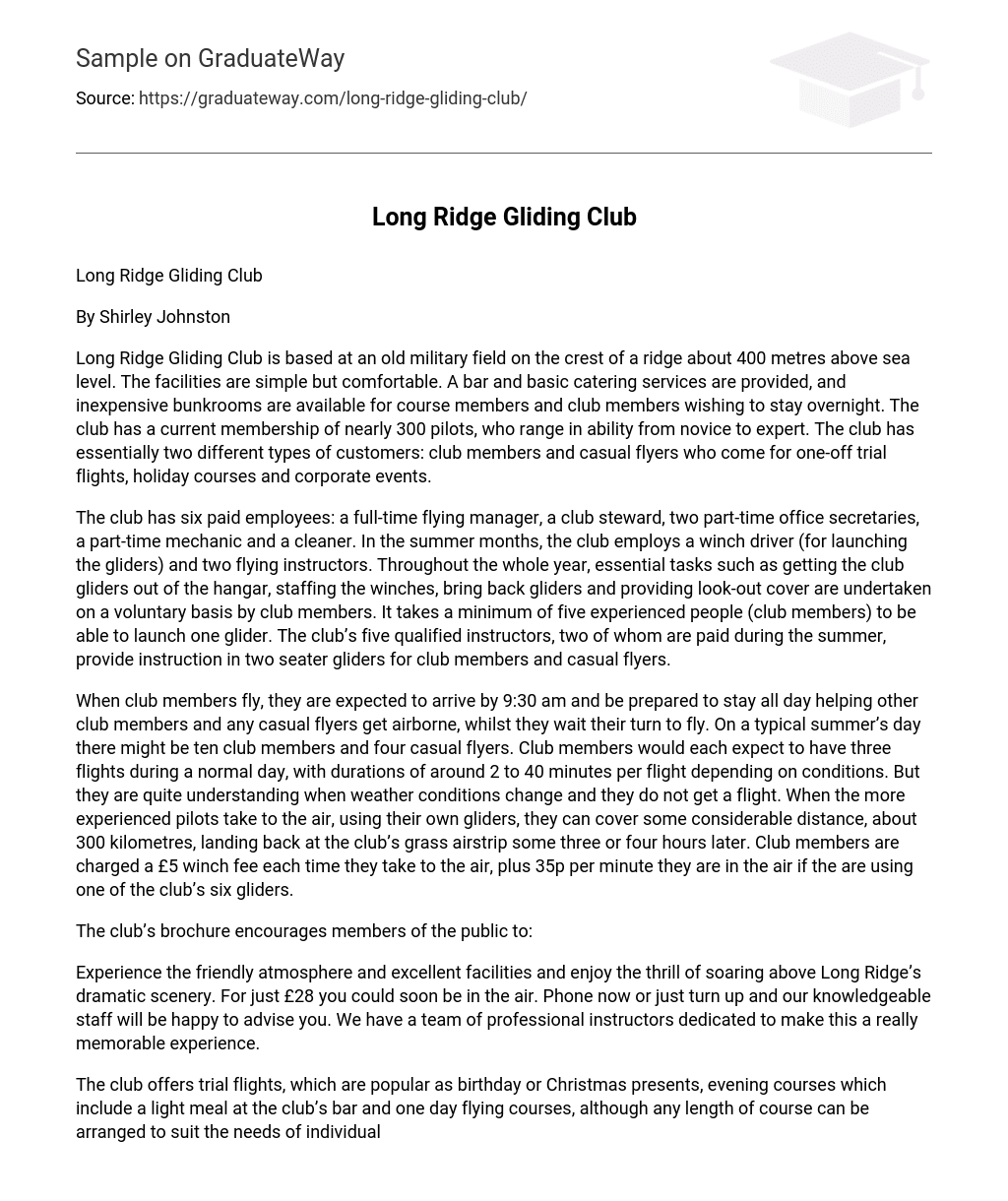By Shirley Johnston Long Ridge Gliding Club is based at an old military field on the crest of a ridge about 400 metres above sea level. The facilities are simple but comfortable.
A bar and basic catering services are provided, and inexpensive bunkrooms are available for course members and club members wishing to stay overnight. The club has a current membership of nearly 300 pilots, who range in ability from novice to expert. The club has essentially two different types of customers: club members and casual flyers who come for one-off trial flights, holiday courses and corporate events. The club has six paid employees: a full-time flying manager, a club steward, two part-time office secretaries, a part-time mechanic and a cleaner. In the summer months, the club employs a winch driver (for launching the gliders) and two flying instructors.
Throughout the whole year, essential tasks such as getting the club gliders out of the hangar, staffing the winches, bring back gliders and providing look-out cover are undertaken on a voluntary basis by club members. It takes a minimum of five experienced people (club members) to be able to launch one glider. The club’s five qualified instructors, two of whom are paid during the summer, provide instruction in two seater gliders for club members and casual flyers. When club members fly, they are expected to arrive by 9:30 am and be prepared to stay all day helping other club members and any casual flyers get airborne, whilst they wait their turn to fly.
On a typical summer’s day there might be ten club members and four casual flyers. Club members would each expect to have three flights during a normal day, with durations of around 2 to 40 minutes per flight depending on conditions. But they are quite understanding when weather conditions change and they do not get a flight. When the more experienced pilots take to the air, using their own gliders, they can cover some considerable distance, about 300 kilometres, landing back at the club’s grass airstrip some three or four hours later.
Club members are charged a £5 winch fee each time they take to the air, plus 35p per minute they are in the air if the are using one of the club’s six gliders. The club’s brochure encourages members of the public to: Experience the friendly atmosphere and excellent facilities and enjoy the thrill of soaring above Long Ridge’s dramatic scenery. For just £28 you could soon be in the air. Phone now or just turn up and our knowledgeable staff will be happy to advise you. We have a team of professional instructors dedicated to make this a really memorable experience.
The club offers trial flights, which are popular as birthday or Christmas presents, evening courses which include a light meal at the club’s bar and one day flying courses, although any length of course can be arranged to suit the needs of individuals or groups. Income from casual flyers is small compared with membership income and the club views casual flying as a ‘loss leader’ to generate club memberships, which are £200 per annum. Members of the public are encouraged to book trial flights in advance during the week, although at weekends they can just turn up and fly on a first-come, first-served basis. Trial flights and courses are dealt with by the club’s administration, which is run from a cabin close to the car park and is staffed most weekday mornings from 9:00 am to 1.00 pm. An answer-phone takes messages at other times. The launch point is out of sight, 1.5 kilometres from the cabin, although club members can let themselves onto the airfield and drive there.
At the launch point the casual flyers might have to stand and wait for some time until a club member has time to find out what they want. Even when a flight has been pre-booked, casual flyers may then be kept waiting, on the exposed and often windy airfield, for up to two hours before their flight, depending on how many club members are present. Occasionally, they will turn up for a pre-booked trial flight and will be turned away because there are not enough club members present to get a glider into the air. The casual flyers are encouraged to help out with the routine tasks but often seem reluctant to do so.
After their flight they are left to find their own way back to their cars. The club chairman is under some pressure from members to end trial flights. Although they provide a very useful resource of income form the hard-pressed club (750 were sold in the previous year), only a handful hand been converted into club memberships. But it results in the club making a small annual profit of around £10,000.
Questions 1. Evaluate the service to club members and casual flyers and complete the following table. Club Member Casual Flyers Product Customers Product range Design changes Delivery Quality Volume per service type Profit margins Competitive Factors Order winners Qualifiers Less important Internal performance objectives 2. Discuss and chart the five performance objectives to show the differing expectations of club members and casual flyers and compare these with the actual service delivered. (In this case, quality has three dimensions: service quality, quality of facilities and product quality.) 3. What advice would you give to the chairman? Note: You could consider five possible options: a. Do nothing. b. End trial flights. c. Create two processes to look after the two types of customers. d. Amend the process- to deal better with the casuals without unduly affecting the members.
e. Better manage casuals’ expectations





